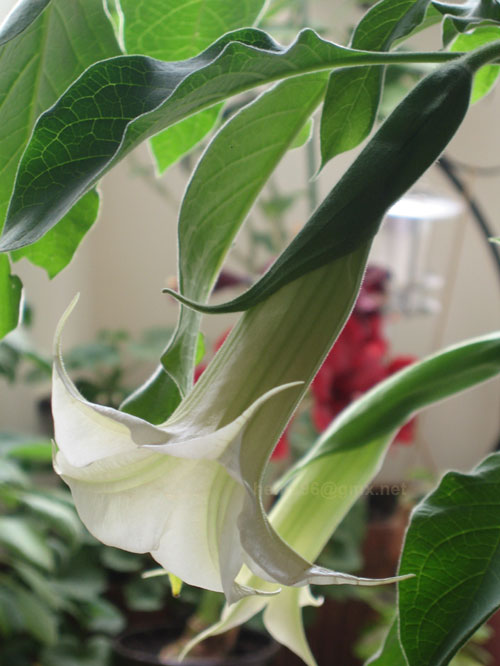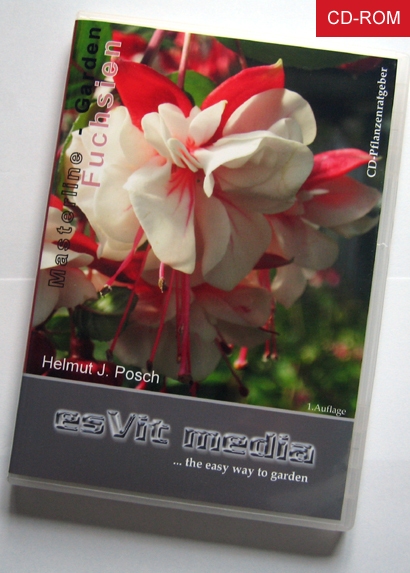Angel's Trumpets - the shooting stars amongst the pot plants
Those who are looking for some very imposant flowering pot plants for August and September are certainly well served with Angel's trumpets. Sometimes, the seductive scent that the plants are spreading in warm midsummer nights is also a factor for choosing these plants. The wild species, originating all in Southern America have been recently further developed by breeders from Germany and US - today a broad spectrum of interesting hybrids is available to the gardner.
Brugmansia or Datura - a good question - for a long time especially in Central Europe Angel's Trumpets have been categorized as Daturas - today a related plant genus. Although there have been some intensions at the end of the 19th century to separate the shrubby and treelike growing plants from those which grow like perennials (hence the name) - this has not been made. It was in 1973 - after intensive field studies for a thesis in South America by T.E. Lockwood, that the plant groups where separated. The thesis itself was never pubished, but W.E. Wade refered later to his work. Brugmansias belong botanically to the large group of genus of the Nightshade-Family (Solanaceae) and are related with other interesting garden plants like Cestrum, Iochroma, Nicotinana (tabacco), tomatoes or potatoes. The plants are in all parts poisonous (contain several tropane alkaloids) and therefore the have in their countries of origin very often an ethno-botanic background - they are used as drugs for shamanic rituals, to cure rheumatic diseases or motion sickness. The main alkaloid is besides some others scopolamine which has been recently of scientic interest. Nowadays racemic hyoscyamine - better known as atropine is used in eye surgeries as sedativum.

Brugmansia - a small manageable plant genus.
The wild species and the naturally occuring hybrids:
Brugmansia arborea (L.) Lagerh.
Brugmansia aurea Lagerh.
Brugmansia insignis (Barb. Rodr.) Preissel
Brugmansia sanguinea (Ruiz & Pav.) D. Don
Brugmansia suaveolens (Humb. & Bonpl. ex Willd.) Bercht. & J. Presl.
Brugmansia versicolor Lagerh.
Brugmansia vulcanicola (Barclay) Schultes
Brugmansia x candida Pers. (= B. aurea x B. versicolor)
Brugmansia x dolichocarpa
Brugmansia x flava* (Herklotz) ex Preissel
A special wild species, which is widely spread in southern Colombia and in Ecuador and which has been of interest for breeders is Brugmansia vulcanicola (it is very often seen listed as Brugmansia sanguinea ssp. vulcanicola). Unfortunately this wild species is not very often seen in Europe and it's hybrids with sanguinea are like B. sanguinea itself not resistant to attacks of diseases transmitted by plant viruses (Colombian Datura Virus - abbreviated CDV).
* the name x flava, which has been used for Arborea x Sanguinea-Hybrids, maybe dropped by botanists and replaced by x rubella (Saff. 1921). Changes in nomenclature are not uncommon in botany and regulated by rules of priority in naming. In this case we feel it is incorrect.
Sometimes other names are included to the wild species listing, such as Brugmansia x cubensis (for hybrids of B. xcandida x B. suaveolens) on. The name 'Culebra' has been used for a small leaved variety which was regarded over a long periode of time as separate plant species. It turned out that the plant is an Aurea-hybrid.
It remains to mention that wild species and naturally occuring hybrids have been additionally divided into two subgroups (sometimes wrongly called sections). This grouping gives the plant enthusiast and grower special notes for growing them. The groups are called Brugmansia (warm group) and Sphaerocarpium (cold group). Sphaerocarpium is referring to the special form of the bulbous fruits.
In the last one all species and hybrids are found that are ranked under insiders belonging to the so called cold group. These are Brugmansia arborea, Brugmansia sanguinea, Brugmansia vulcanicola and Brugmansia x flava (maybe in the future x rubella). They all prefer cool locations in the garden (best under 18°C - around 10°C at nights) to set blooms and they need higher air humidity - these are the reasons why they are thought to be tricky and problematic in cultivation - but they aren't. Except for B. arborea and some Flavas all other species and hybrids lack in fragrance.
The culture of Brugmansias
Brugmansias of the name group Brugmansia are easily cultivated plants, this presupposes that some things in dealing with the plant are taken into account. The plants prefer semi shady to sunny locations in the garden, need a loose growing medium rich in nutrients, are strong uptakers (have a high demand for nutrients - especially nitrogen) and need a good level of moisture during the summer months. For addional donation of magnisiasulphate (Epsom-salt) they are grateful. Fertilize your plants during the growing season with a fertilizer rich in nitrogren (2-3 times a week about 5g/l). If the plants have some deficencies then this expressed by green-yellowisch colour of the leaves and a reduced will to set blooms. Plants that are cultivated in a peat based soil medium should be also fertilized with an iron/manganese-fertilizer (chelat-basis) to avoid chlorosis on the leaves. Also a certain calzium amount is benefical - so there is no need to water them with rain water.
There are a few common plant pests like aphids - which are also transmitting the CD-virus that could harm your plants. So look out for whiteflies, red spider mites, mites in general, caterpillars and the typically on pot plants occuring fungal diseases and take the appropriate precautionary measures.
Note: It has also shown that angel's trumpets are well suited for hydroponics. Plants get the nutrients in an optimal way!
Propagation
Propagation of Brugmansias is easy to tricky depending to the species you are loooking at. In Central Europe the widly spread gardens cvs derived from suaveolens are easily propagated by cuttings (sometimes wrapping the cuttings in a moistened kitchen towel or placing them in a glas of water is sufficient). Cuttings of plants of the cold group need more attention to root successfully. The grade of lignification and the time in the garden season when the cuttings are taken is here very important! If you want to be sure not to loose the plant material then it is better to airlayer the parts of the plant by using a rooting hormone (like Superthrive).
Angel's Trumpets are also easily propagated by seeds. You can get seeds from specialized plant societies, which makes the access to modern hybrid material a little bit easier. If you sow the seeds after a warm water soak and pealing early in the season and hold the upcoming seedlings under good growing conditions there is chance to get flowers already in the first season (approx. 6 months onwards).
Hibernation
Different - depending on the hybrid or species. For most hybrids a dark, frost-free place in the house or cellar is more than sufficient. Plants which are members of the cold group prefer a bright hibernations place. Winter minimum temperatures are around 8 and 10°C - for B. insignis, B. versicolor and their hybrids better >12°C. Keep the plants dry and water only if necessary.
Fertilization
Brugmansias demand high doses of nutrients during the hole gardening season (except cold group plants). In direct relation to this you will find plant growth and flower developement. After moving the plants from the hibernations place into the garden it is essential that you start very soon fertilizing them:
Feritilization schema:
2-3 table spoones of a green or red fertilizer diluted in 10l water - 2-3 times a week
Note: Pay attention to adapt the fertilizer to the current growing phase your plant is in. At the beginning of september it is time to stop fertilizing them - so that plants have enough time to prepare for hibernation.
If you use a peat-based growing material is essential to avoid chlorosis. Be sure that you provide your plants also a certain amount of trace elements!
Literature
- Preissel, Ulrike; Hans-Georg Preissel, Brugmansia and Datura: Angel's Trumpets and Thorn Apples Buffalo, New York: Firefly Books, 2002
- Das grosse Buch der Engelstrompeten. (Taschenbuch) by Anne Kirchner-Abel, Werner Abel, Vera M. Hesels, Akawa Privatgarten Verlag; Edition: 1. Aufl. (December 2003)
Web links:
www.ibrugs.com (International Brugmansia Society and ICRA by merge with former ABADS)
www.brugmansia.us (a Brugmansia forum for Brugmansia friends and breeders)
www.engelstrompeten.de - Langenbuscher Garten
www.hannover.de - Brugmansias at Herrenhäuser Gaerten / Hannover-Germany

